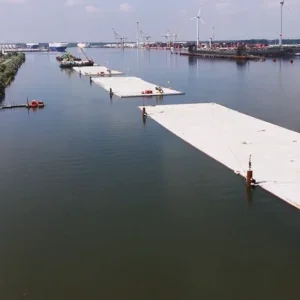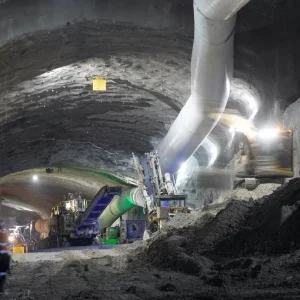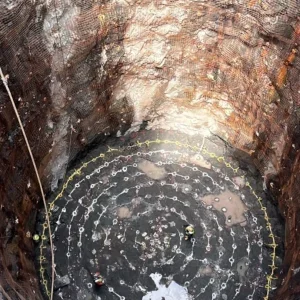Where tunnel excavation is carried out in soils with high clay content, a loss in stability of the tunnel face is often prevented by creating a support pressure. One of the problems that can occur while boring through fine-grained soil is the adherence of clay to the TBM cutting wheel, inside the excavation chamber or in the transportation line, which might lead to long delays in progress. Since the economic success of a tunnelling project can depend very much on the clogging potential of the encountered clay formations, it is of vital importance to understand this phenomenon and find possible solutions. Currently there is no effective soil conditioning technique based on scientific data. This article shows the clay mineralogy for tunnel projects with clogging problems and new handling methods based on the ‘diffuse double layer’ (DDL) theory. The decision on which tunnelling method to use is prioritized based on the lithological characteristics of the soil to be bored. A slurry shield machine is used in incoherent and highly permeable soils with no fine grain content (figure 1). This method, however, requires a complex preparation plant for slurry, the recycling of material and disposal of large amounts of sludge (Greatti, 2004). EPBMs are now the most widely used technology because they can operate in a much broader spectrum of lithological conditions and do not require expensive additional equipment. The soil permeability for EPB drives can reach values of up to k=10-3m/s for the most porous soils (e.g. BPNL Lyon-Turin) and comes down to practically impermeable clay (Heathrow T5) (Langmaac, K 2006).
The face support pressure in an EPB shield is maintained using the soil either as it is excavated or conditioned (Kupferroth et al, 2001). With a slurry machine it is not always possible to stabilise a tunnel face in cohesionless soil below the water table. In contrast with EPBs, (provided that water inflows are controlled) major collapses are not possible as there is no space for the soil to flow into (Milligan, 2000).
However, EPB shields can only be used in soils that have specific characteristics. In fact, soft clays can cause instabilities at the tunnel face when the following equation is not verified (Peck, 1969):

If the undrained cohesion is less than the calculated value, an extrusion of clay into the hollow space can occur. Thus, the soil where the EPB technology is suitable must have the characteristic that its plasticity can be increased and that it can be remoulded, while maintaining a sufficient strength in the screw conveyor that supports the pressure. This can be achieved by adjusting the consistency of the material in the excavation chamber by means of water or a conditioning agent, which in the case of the EPB technology could be foams and polymers. The choice of a specific product depends on the geomechanical characteristics of the excavated ground (Greatti, 2004). Since this technique is used in homogeneous as well as in heterogeneous ground conditions, the TBM cannot be designed for the optimum of a specific geology, but for the overall optimum (Langmaack and Feng, 2005).
Clogging
When excavating with a TBM, adhesion of clay to parts of the machine or the transportation equipment can occur in different steps of the construction processes: cutting, conveying, deposition, etc. However, such clogging problems arise not only in tunnel construction, but also in other industrial areas such as the processing of clays in the mineralogical industry, dredging operations in earthworks or vertical and horizontal boring as well as in other fields of geotechnical engineering. In each of these areas, clogging may cause a severe reduction in performance.
Unfortunately, there have not been many case studies on clogging so far, especially not when compared with the large number of tunnelling projects worldwide where EPB machines are employed. According to Thewes (1999), in earthwork operations clogging can occur even when the clay content is low. However, no information is given on the minimum clay amount. Kuhn (1989), Schlick (1989) and Beretitsch (1992) investigated the influence of adhesion on the planning and costs of earthwork projects. Other research has been done on the ‘bit balling’ phenomenon, which can occur during deep boring work (Garnier and van Lingen, 1959; Darley and Gray, 1988). Bit balling is a mass of sticky consolidated material, usually drill cuttings, that have collected on drill pipe, drill collars, bits and so forth. Navin et al, (1995), Beyer (1995), and Smith (1997) reported clogging problems during tunnel excavation due to plastic clays, leading to the blockage of the openings of the cutting wheels. According to Borghi (2006), the greatest problems for EPB drives were encountered in highly plastic clays, resulting in high cutterhead torque and difficulties in controlling the face pressure. Milligan (2000) summarised some of the reported case studies.
In figure 2 some information from published case studies about problems encountered during EPB drives in soils with high clay content is listed. However, it is almost impossible to obtain information on the mineralogy of the respective clays.
In the course of a joint research project (Feinendegen et al., 2010) the clay mineralogy of clays from several tunnelling projects with known clogging problems was taken into account and XRD (X-ray diffraction) mineralogical analyses were performed on several clays. Unfortunately, due to the small number of projects, a general statistical analysis is not possible.
Modification of pore fluids chemistry
Jancsecz (1991) was the first who investigated clayey samples with regard to mechanical tunnel driving. He describes the dependence of the adhesion on simple soil mechanical parameters. The results from separation tests are compared to the undrained shear strength, the activity and the plastic limits of the clays. A maximum of adhesion can be observed between the plastic limit (PL) and the liquid limit (LL) as well as an increase in adhesion with increasing plasticity (figure 4).
Very interesting is also his study of the activity (A), which is represented by the plasticity index (PI/IP) divided by the percentage of particles = 0.002 mm. Different types of clays have different specific surface areas which control how much water is required to move a soil from one phase to another such as across the liquid limit or the plastic limit. From the activity one can predict the dominant clay type present in a soil sample. High activity shows large volume changes when wetted and large shrinkage when dried. Soils with a high activity are chemically very reactive (Skempton, 1953). The engineering properties of fine-grained soils are, besides many other conditions, strongly susceptible to changes in the stress state, the chemistry of the pore medium, wetting and drying cycles and temperature.
Most soil classification systems arbitrarily define clay particles as having an effective size of two microns or less and do not account for the clay mineral type and amount of exchangeable cation; probably the most important properties of the clay. Clay minerals are characterised by strong repulsive and attractive forces that vary significantly depending on their mineralogical composition and the net negative charge they carry on their surface, as well as the positive or negative charges on their edges. The electrical forces and the pore medium chemistry gain greater importance when the water content is high and the effective stress state is low. Since variations in mineralogy, cation exchange capacity and associated surface forces have a great influence on several physical and engineering properties (Sridharan, 2002) the clay mineralogy is an important factor in geotechnical engineering with respect to fine-grained soils.
Atterberg limits, which were originally developed for the purpose of soil classification, have been determined on pure clays with different pore fluids. In the recent past various attempts have been made also to correlate the Atterberg Limits with various soil properties like mineralogy, activity and swelling behaviour.
Hence, understanding the mechanism controlling the liquid limit behavior assumes importance. Sridharan and Venkatappa Rao (1979) have discussed the possible mechanisms governing the liquid limit of kaolinite and smectite type of clays. Figure 5 shows the liquid limit for these two clays with variation of the electrolyte concentration. From figure 5 it can be seen that the two clays behave in a strikingly opposite manner with respect to the change in pore fluids. Whereas a decrease in liquid limit is observed for Nasmectite with a decrease in dielectric constant of the pore medium, no change (or slight increase) of liquid limit has been recorded for kaolinite. For Na-smectite, the liquid limit decreases significantly from a value of 455 per cent for water (dielectric constant = 79.5) to 89 per cent for a 75:25 ethanol-water mix (dielectric constant 38.28). No liquid limit has been determined for pure ethanol with Na-smectite since the clay behaved more or less like sand showing no coherence anymore. From figure 5 it is clear that kaolinite and Nasmectite, the two extreme types of clay minerals, behave quite differently under any given set of physicochemical conditions. Hence, the mechanism that controls the liquid limits of kaolinitic and smectitic soils cannot be the same (Sridharan 2002).
To explain the variation of liquid limit (i.e. of the mechanical properties) the colloidal characteristics of clays have to be taken into account. Extensive studies conducted at the Department of Engineering Geology and Hydrogeology of RWTH Aachen University revealed the existence of two different mechanisms governing the liquid limit of soils, taking into account the clay mineralogy and the pore medium chemistry. The results agree with those gathered by Sridharan and Venkatappa Rao (1979) and Sridharan et al. (1986, 1988). The properties of clays are determined and dominated by their large surface area per mass and hence, by their surface forces. To understand the behavior of clayey soil, it is necessary to consider the crystal structure of the clay minerals and the surface chemistry of the clay-water suspensions.
Since both attractive and repulsive forces of an electrical nature exist between clay particles (Rosenqvist, 1955; van Olphen, 1963), many factors are responsible for a net attractive or repulsive force. The primary parameters affecting the repulsive forces are the distance of the particles, the dielectric constant and the electrolyte concentration of the pore fluids (Lambe, 1958; van Olphen, 1963).
To be continued…
The final part of this paper will cover RWTH Aachen University’s new tests for clay and handling methods.
Figure 1, the application ranges of pressurised slurry and EPB shield machines according to particle diameter (d mm) and distribution in various loose ground types [After Herrenknecht AG] Figure 2, Case studies of tunnels with clogging problems Figure 3, clay mineralogical analysis on samples with known clogging problems Figure 4 correlation between adhesion and classical soil mechanics parameters Figure 5, liquid limit for Nasmectite and kaolinite for pore media with different dielectric constants formula







